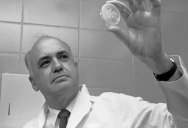These 10 People Made the World a Better Place. More People Should Know their Names
by twistedsifter
There are countless unsung heroes throughout history that are deserving of greater recognition and appreciation. This post strives to shed light on ten such remarkable individuals who have impacted the world. If you have suggestions for other notable persons, please let me know in the comments so I can do a follow-up post and we can continue to exalt these inspirational people and celebrate and share their incredible stories.
1. Niels Bohlin
Inventor of the Three-Point Seatbelt

On July 10, 1962, the US Patent Office issued Swedish engineer Nils Bohlin (July 17, 1920 – Sept. 26, 2002) a patent for the three-point seatbelt. Bolin worked for the Volvo Car Corporation and designed his three-point system in less than a year. Volvo first introduced the seatbelt on its cars in 1959. Consisting of two straps that joined at the hip level and fastened into a single anchor point, the three-point belt significantly reduced injuries by effectively holding both the upper and lower body and reducing the impact of the swift deceleration that occurred in a crash. [Source]
Volvo released the new seat belt design for free to other car manufacturers and it quickly became standard worldwide. The National Traffic and Motor Vehicle Safety Act of 1966 made seat belts a required feature on all new American vehicles from the 1968 model year onward. The use of seat belts has been estimated to reduce the risk of fatalities and serious injuries from collisions by about 50 percent [Source]. A Volvo research team recently found Bohlin’s invention had saved about 1 million lives. [Source]
In 1974, he was awarded The Ralph Isbrandt Automotive Safety Engineering Award, and in 1989 he was inducted into the Hall of Fame for Safety and Health. He received a gold medal from Royal Swedish Academy of Engineering Science in 1995 and in 1999, was inducted into the Automotive Hall of Fame. He retired from Volvo in 1985 and was posthumously inducted into the National Inventors Hall of Fame. [Source]
2. Maurice Ralph Hilleman
Saved More Lives than Any Other
Medical Scientist of the 20th Century

Maurice Ralph Hilleman (August 30, 1919 – April 11, 2005) was an American microbiologist who specialized in vaccinology and developed over 36 vaccines, more than any other scientist. Of the 14 vaccines routinely recommended in current vaccine schedules, he developed eight: those for measles, mumps, hepatitis A, hepatitis B, chickenpox, meningitis, pneumonia and Haemophilus influenzae bacteria. [Source]
Hilleman was also the first to identify how the influenza virus mutates, and he virtually single-handedly spearheaded creation of the vaccine that prevented the Asian flu outbreak of 1957 from becoming a repeat of the 1918 Spanish flu pandemic, which killed 20 million people worldwide [Source]. He also created the world’s first licensed vaccine against a viral cancer, which blocked Marek’s disease, a lymphoma of chickens. The development revolutionized the poultry industry. [Source]
In 1988 President Ronald Reagan presented him with the National Medal of Science, the nation’s highest scientific honor. He received the Prince Mahidol Award from the King of Thailand for the advancement of public health, as well as a special lifetime achievement award from the World Health Organization. [Source]
3. Vasili Arkhipov and Stanislav Petrov
Preventers of Nuclear War

On September 26, 1983, Lt. Col. Stanislav Petrov was duty officer at Serpukhov-15, the secret bunker outside Moscow that monitored the Soviet Union’s early-warning satellite system. Shortly after midnight, one of the satellites signaled Moscow that the United States had launched five ballistic missiles at Russia. The responsibility fell to Petrov, then a 44-year-old lieutenant colonel, to make a decision: Was it for real? The alarm came during tense times. Just weeks prior, Soviet pilots had shot down Korean Air Lines Flight 007 and NATO military exercise, known as Able Archer were about to begin.
Despite the electronic evidence, Petrov decided – and advised the others – that the satellite alert was a false alarm, a call that may have averted a nuclear holocaust. But he was relentlessly interrogated afterward, was never rewarded for his decision and today is a long-forgotten pensioner living in a town outside Moscow. [Source]
Vasili Alexandrovich Arkhipov (30 Jan. 1926 – 19 Aug. 1998) was a Soviet Navy officer. During the Cuban Missile Crisis, he prevented the launch of a nuclear torpedo and likely prevented a nuclear war. Thomas Blanton (then director of the National Security Archive) said in 2002 that “a guy called Vasili Arkhipov saved the world”. [Source]
On 27 October 1962, during the Cuban Missile Crisis, a group of eleven United States Navy destroyers and the aircraft carrier USS Randolph located the diesel-powered nuclear-armed Soviet Foxtrot-class submarine B-59 near Cuba. Despite being in international waters, the Americans started dropping practice depth charges, explosives intended to force the submarine to come to the surface for identification. There had been no contact from Moscow for a number of days and the sub was too deep to monitor any radio traffic, so those on board did not know whether war had broken out. The captain of the submarine, Valentin Grigorievitch Savitsky, believing that a war might already have started, wanted to launch a nuclear torpedo.
Three officers on board the submarine – Savitsky, the political officer Ivan Semonovich Maslennikov, and the second-in-command Arkhipov – were authorized to launch the torpedo if agreeing unanimously in favor of doing so. An argument broke out among the three, in which only Arkhipov was against the launch. Arkhipov eventually persuaded Savitsky to surface the submarine. [Source]
4. Chuck Feeney
The Billionaire Who Is Trying To Go Broke

Charles Francis Feeney (born April 23 1931 in Elizabeth, New Jersey) is an Irish-American businessman who made his fortune as a co-founder of the Duty Free Shoppers Group. The concept of “duty free shopping”—offering high-end concessions to travelers, free of import taxes—was in its infancy when Feeney founded DFS on November 7, 1960. DFS would soon became the world’s largest travel retailer. During the same period, Feeney banked nearly $334 million in dividends that he in turn invested into hotels, retail shops, clothing companies and tech startups. In 1996, his DFS interests were acquired by Louis Vuitton Moët Hennessy (LVMH) for $1.63 billion. Over his career Feeney amassed a $7.5 billion fortune that he intends to give away entirely in his lifetime.
His foundation, The Atlantic Philanthropies, has funnelled $6.2 billion into education, science, health care, aging and civil rights in the U.S., Australia, Vietnam, Bermuda, South Africa and Ireland. The remaining $1.3 billion will be spent by 2016, and the foundation will be shuttered in 2020. [Source]
According to Forbes, Bill Gates and Warren Buffett credit Feeney as a major inspiration for both the $30 billion Bill & Melinda Gates Foundation and the Giving Pledge, a commitment by the world’s wealthiest individuals and families to dedicate the majority of their wealth to philanthropy. As of July 2013, 113 billionaire individuals and couples and one family group have signed the pledge. [Source]
“I had one idea that never changed in my mind—that you should use your wealth to help people. I try to live a normal life, the way I grew up,” Feeney says. “I set out to work hard, not to get rich.” [Source]
5. Norman Borlaug
The Man Who Saved a Billion Lives

Norman Ernest Borlaug (March 25, 1914 – Sept. 12, 2009) was an American biologist, humanitarian and Nobel laureate who has been called “the father of the Green Revolution”, “agriculture’s greatest spokesperson” and “The Man Who Saved A Billion Lives”. He is one of seven people to have won the Nobel Peace Prize, the Presidential Medal of Freedom and the Congressional Gold Medal and was also awarded the Padma Vibhushan, India’s second highest civilian honor.
Borlaug received his B.Sc. Biology 1937 and Ph.D. in plant pathology and genetics from the University of Minnesota in 1942. He took up an agricultural research position in Mexico, where he developed semi-dwarf, high-yield, disease-resistant wheat varieties. During the mid-20th century, Borlaug led the introduction of these high-yielding varieties combined with modern agricultural production techniques to Mexico, Pakistan, and India. As a result, Mexico became a net exporter of wheat by 1963. Between 1965 and 1970, wheat yields nearly doubled in Pakistan and India, greatly improving the food security in those nations. These collective increases in yield have been labeled the Green Revolution, and Borlaug is often credited with saving over a billion people worldwide from starvation. He was awarded the Nobel Peace Prize in 1970 in recognition of his contributions to world peace through increasing food supply.
6. Henrietta Lacks
The Source of the Oldest and Most Commonly Used
Human Cell Line in Science

Henrietta Lacks (Aug. 1, 1920 – Oct. 4, 1951) was an African-American woman who was the unwitting source of cells (from her cancerous tumor) which were cultured by George Otto Gey to create the first known human immortal cell line for medical research known as the HeLa cell line. [Source]
As the first human cells grown in a lab that were “immortal” (they do not die after a few cell divisions), they could be used for conducting many experiments. This represented an enormous boon to medical and biological research.
By 1954, the HeLa strain of cells was being used by Jonas Salk to develop a vaccine for polio. In 1955 HeLa cells were the first human cells successfully cloned. Demand for the HeLa cells quickly grew. Since they were put into mass production, Henrietta’s cells have been mailed to scientists around the globe for “research into cancer, AIDS, the effects of radiation and toxic substances, gene mapping, and countless other scientific pursuits”. HeLa cells have been used to test human sensitivity to tape, glue, cosmetics, and many other products. Scientists have grown some 20 tons of her cells, and there are almost 11,000 patents involving HeLa cells. [Source]
7. Eugene Lazowski
The Polish Schindler

Dr. Eugene Lazowski (1913 – December 16, 2006) was a Polish medical doctor who saved thousands of Jews during the Holocaust by creating a fake epidemic. Thanks to a medical discovery by his friend, Dr Stanislav Matulewicz, Lazowski created a fake outbreak of Epidemic Typhus, a dangerous infectious disease. Matulewicz discovered that by injecting a healthy person with a “vaccine” of killed bacteria, that person would test positive for Epidemic Typhus without experiencing the symptoms. Lazowski spread it in and around the town of Rozwadów (now a district of Stalowa Wola), which the Germans then quarantined. This saved an estimated 8,000 Polish Jews from certain death in German concentration camps during the Holocaust. [Source]
The Germans were weary of Epidemic Typhus because it was highly contagious. While Jews who tested positive for typhus were normally executed by the Nazis, the doctors injected the non-Jewish population in neighborhoods surrounding the ghettos, knowing that a possibility of widespread outbreak inside would cause Germans to abandon and quarantine the area instead. [Source]
8. James Harrison
The Man with the Golden Arm
James Harrison, known as the Man with the golden arm, is a blood plasma donor from Australia whose unusual plasma composition has been used to make a treatment for Rhesus disease. He has made over 1000 donations throughout his lifetime, and these donations are estimated to have saved over two million unborn babies from the condition.
Born in 1936, Harrison underwent major chest surgery at the age of thirteen, requiring 13 litres of blood. He was in the hospital for three months afterwards. Realizing the blood had saved his life, he made a pledge to start donating blood as soon as he turned eighteen, the then-required age. Mr. Harrison started donating in 1954 and after the first few donations it was discovered that his blood contained an unusually strong and persistent antibody called Rho(D) Immune Globulin. Rho(D) IG is given to Rh(D) negative mothers of unknown or Rh(D) positive babies during and after pregnancy to prevent the creation of antibodies to the blood of a Rh(D) positive child. This antigen sensitization and subsequent incompatibility phenomenon causes Rhesus disease, the most common form of hemolytic disease of the newborn (HDN). [Source]
As blood plasma, in contrast to blood, can be donated as often as every 2–3 weeks, he was able to reach his 1000th donation in May 2011. This results in an average of one donation every three weeks during 57 years. [Source]
9. Willis Carrier
Inventor of Air Conditioning

Willis Haviland Carrier (Nov. 26, 1876 – Oct. 7, 1950) was an American engineer, best known for inventing modern air conditioning. In Buffalo, New York, on July 17, 1902, in response to a quality problem experienced at the Sackett-Wilhelms Lithographing & Publishing Company of Brooklyn, Willis Carrier submitted drawings for what became recognized as the world’s first modern air conditioning system. The 1902 installation marked the birth of air conditioning because of the addition of humidity control, which led to the recognition by authorities in the field that air conditioning must perform four basic functions: 1.) control temperature; 2.) control humidity; 3.) control air circulation and ventilation; 4.) cleanse the air. [Source]
On December 3, 1911, Carrier presented the most significant and epochal document ever prepared on air conditioning – his “Rational Psychrometric Formulae” – at the annual meeting of the American Society of Mechanical Engineers. It became known as the “Magna Carta of Psychrometrics.” This document tied together the concepts of relative humidity, absolute humidity, and dew-point temperature, thus making it possible to design air-conditioning systems to precisely fit the requirements at hand. [Source]
By increasing industrial production in the summer months, air conditioning revolutionized American life. The introduction of residential air conditioning in the 1920s helped start the great migration to the Sunbelt. [Source]
10. Rick Rescorla
Leader of a 9/11 Evacuation

Cyril Richard “Rick” Rescorla (May 27, 1939 – September 11, 2001) was a retired United States Army officer of British birth who served with distinction in Northern Rhodesia as a member of the Northern Rhodesia Police (NRP) and as a soldier in the Vietnam War, where he was a Second Lieutenant in the United States Army. [Source]
At 8:46 a.m. on the morning of September 11, 2001, American Airlines Flight 11 struck World Trade Center Tower 1. Rescorla heard the explosion and saw the Tower burning from his office window. When a Port Authority announcement came over the P.A. system urging people to stay at their desks, Rescorla ignored the announcement, grabbed his bullhorn, walkie-talkie and cell phone, and began systematically ordering Morgan Stanley employees to evacuate, including the 1,000 employees in WTC 5. He directed people down a stairwell from the 44th floor, continuing to calm employees after the building lurched violently following the crash of the second plane 38 floors above. Morgan Stanley executive Bill McMahon stated that even a group of 250 people visiting the offices for a stockbroker training class knew what to do because they had been shown the nearest stairway. [Source]
Rescorla had boosted morale among his men in Vietnam by singing Cornish songs from his youth, and now he did the same in the stairwell, singing songs like one based on the Welsh song “Men of Harlech”. Between songs, Rescorla called his wife, telling her, “Stop crying. I have to get these people out safely. If something should happen to me, I want you to know I’ve never been happier. You made my life.” [Source]
After successfully evacuating most of Morgan Stanley’s 2,687 employees, he went back into the building. When one of his colleagues told him he too had to evacuate Rescorla replied, “As soon as I make sure everyone else is out”. He was last seen on the 10th floor, heading upward, shortly before the tower collapsed. His remains were never found. At the National 9/11 Memorial, Rescorla is memorialized at the South Pool, on Panel S-46. [Source]
If you enjoyed this post, the Sifter
highly recommends:
Trending on TwistedSifter




